Table of Contents
Water
Suppose for some reason your family gets only one bucket of water everyday for a week. Imagine what would happen? Would you be able to cook, clean utensils, wash clothes or bathe? What are the other activities you would not be able to do? What would happen if we do not have easy access to water for a long period of time?
Apart from drinking, there are so many activities for which we use water (Fig. 14.1). Do you have an idea about the quantity of water we use in a single day?
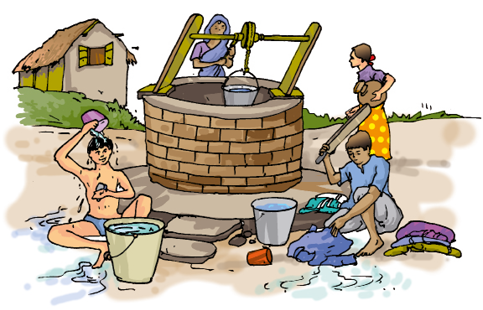
Fig. 14.1 Uses of water
14.1 How Much Water do we Use?
Activity 1
List all the activities for which you use water in a day. Some activities are listed in Table 14.1. Make a similar table in your notebook. Throughout the day, measure the amount of water used for each activity by you and other family members. You may use a mug, a glass, a bucket or any other container to measure the amount of water used.
Table 14.1 Estimation of the amount of water used by your family in a day
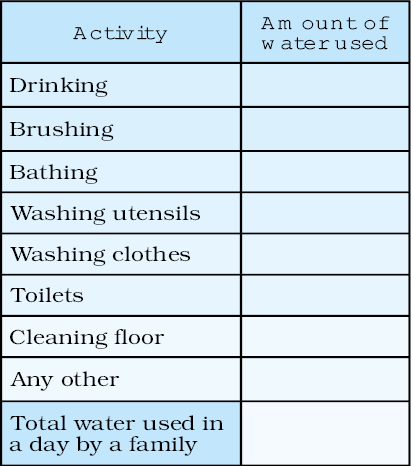
You now have a rough idea as to how much water your family uses in a day. Can you estimate the amount of water used by you for personal cleanliness in a day. Using this information, calculate the amount of water needed by your family in a year. Now, divide this amount by the number of members of your family. This will give an idea of the amount of water needed by one member of your family in a year. Find the number of people that live in your village or town. You may now get an idea of the amount of water needed by your village or town in a year.
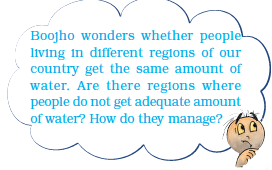
You have listed a number of activities for which you use water. Do you think, our water requirement is limited to activities like these? We use wheat, rice, pulses, vegetables and many other food items everyday. We know that some of the fibres that we use for making fabric come from plants. Is water not needed to grow these? Can you think of some more uses of water? Water is used in industries for producing almost all the things that we use. So, we need water not only for our daily activities but also for producing many things.
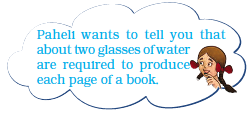
14.2 Where do we get Water From?
Where do you get the water that you use? Some of you may say, “We draw water from a river, spring, pond, well or a hand pump”. Some others might say, “We get water from taps”. Have you ever wondered where water in the taps comes from? Water that we get from taps is also drawn from a lake or a river or a well (Fig. 14.2). It is then supplied through a network of pipes.
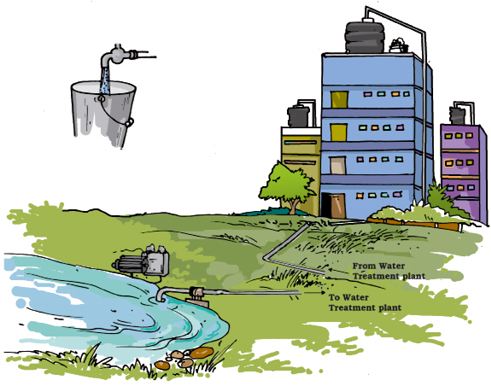
Fig. 14.2 Water in taps comes from rivers, lakes, borewell or wells
Each of us may be getting water into our homes in different ways. But, finally, all of us get water from the same sources such as ponds, lakes, rivers and wells.
We have discussed some of the sources of water. Where does the water come from, to fill these ponds, lakes, rivers and wells?
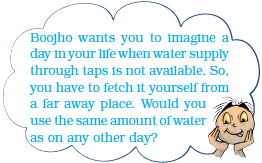
Do you know that about two thirds of the Earth is covered with water? Most of this water is in oceans and seas (Fig. 14.3).
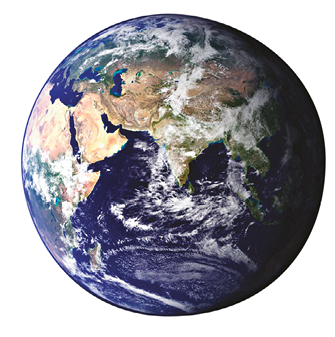
Fig. 14.3 Oceans cover a major part of the earth
The water in the oceans and seas has many salts dissolved in it — the water is saline. So, it is not fit for drinking and other domestic, agricultural and industrial needs. You might have heard the famous lines of the poem “Rime of the Ancient Mariner” written by S.T. Coleridge in 1798:
“Water water every where
Nor any drop to drink”
Here the poet has described the plight of sailors on a ship lost in the ocean.
Yet, oceans play an important role in supplying the water that we use. Do you find this surprising? After all, the water that we use is not salty. Many of us live in places far away from the oceans. Does the water supply in these places also depend on the oceans? How does the ocean water reach ponds, lakes, rivers and wells, which supply us water? How come the water from these sources is not saline anymore?
That is where the water cycle comes in!
14.3 Water Cycle
Disappearing Trick of Water
How many times have you noticed that water spilled on a floor dries up after some time? The water seems to disappear. Similarly, water disappears from wet clothes as they dry up (Fig. 14.4). Water from wet roads, rooftops and a few other places also disappears after the rains. Where does this water go?
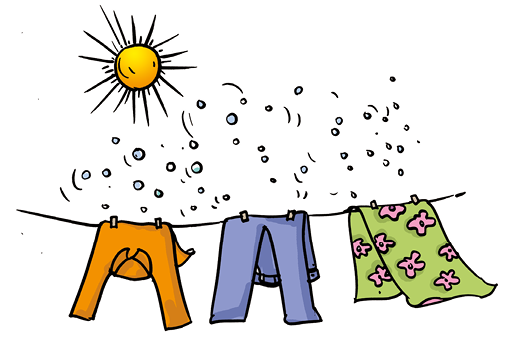
Fig. 14.4 Clothes drying on a clothes-line
Do you remember Activity 6 in Chapter 5 in which water with salt dissolved in it was heated? What did we find? The water evaporated and the salt was left behind. This activity gives us an idea that, on heating, water changes into its vapour. We also realise from this activity, that water vapour does not carry away the salt with it. Water vapours so formed become a part of the air and cannot usually be seen. We also found that heating is essential to convert water into its vapour. However, we have seen that water changes into its vapour also from the fields, roads, rooftops and other land areas. We also discussed in Chapter 5 that to obtain salt, water from the sea is left in shallow pits to let the water evaporate. From where does this water get the heat it needs to evaporate? Let us find out.
Activity 2
Take two similar plates. Place one of the plates in sunlight and keep the other under shade. Now, pour equal amount of water in each of the plates (Fig. 14.5). You can use a cap of a bottle to measure water. Make sure that water does not spill over. Observe the two plates after every 15 minutes. Does the water seem to disappear? From which plate does it disappear first? What is the source of heat for this evaporation?
During the daytime, sunlight falls on the water in oceans, rivers, lakes and ponds. The fields and other land areas also receive sunlight. As a result, water from all these places continuously changes into vapour. However, the salts dissolved in the water are left behind.
In Activity 2, did you find that water also disappeared from the plate kept in the shade, though it could have taken more time? Does the heat from the sunlight reach here? Yes, during the daytime all the air surrounding us gets heated. This warm air provides heat for evaporation of water in the shade. Thus, evaporation takes place from all open surfaces of water. As a result, water vapour gets continuously added to air. However, evaporation of water is a slow process. That is why we rarely notice its loss from a bucket full of water. In sunlight, evaporation takes place faster. On heating water on a burner, its evaporation takes place even faster. Is there any other process through which water vapour gets transferred into air?
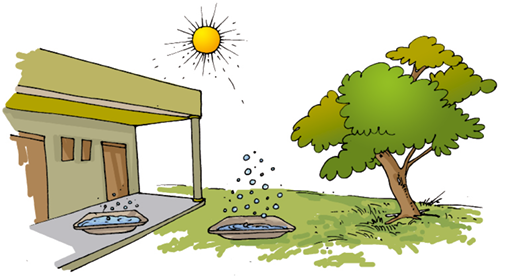
Fig.14.5 Evaporation of water in sunlight and in shade
Loss of Water by Plants
You have learnt in Chapter 7 that plants need water to grow. Plants use a part of this water to prepare their food and retain some of it in their different parts. Remaining part of this water is released by the plants into air, as water vapour through the process of transpiration. Do you remember observing transpiration of water by plants in Activity 4 in Chapter 7?
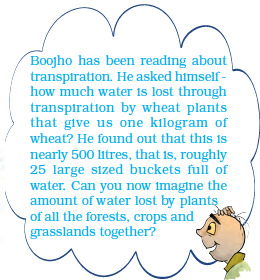
Water vapour enters the air through the processes of evaporation and transpiration. Is it lost for ever? No, we get it back again, as we will see.
How are clouds formed?
Activity 3
Take a glass half filled with water. Wipe the glass from the outside with a clean piece of cloth. Add some ice into the water. Wait for one or two minutes. Observe the changes that take place on the outer surface of the glass (Fig.14.6).
From where do water drops appear on the outer side of the glass? The cold surface of the glass containing iced water, cools the air around it, and the water vapour of the air condenses on the surface of the glass. We noticed this process of condensation in Activity 7 in Chapter 5.
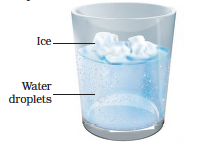
Fig. 14.6 Drops of water appear on outer surface of the glass containing water with ice
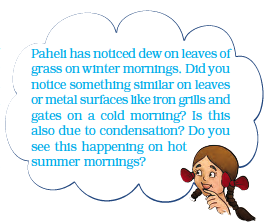
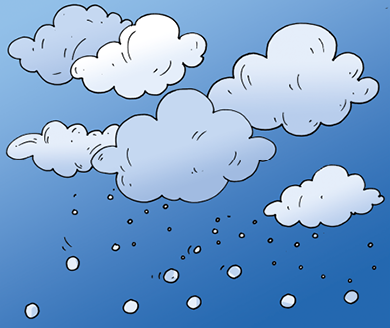
Fig. 14.7 Clouds
It so happens that many droplets of water come together to form larger sized drops of water. Some drops of water become so heavy that they begin to fall. These falling water-drops are, what we call rain. In special conditions, it may also fall as hail or snow.
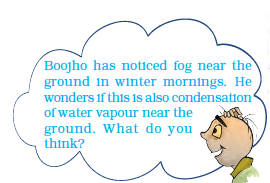
Thus, water in the form of vapour goes into air by evaporation and transpiration, forms clouds, and then comes back to the ground as rain, hail or snow.
14.4 Back to the Oceans
What happens to the water that rain and snow bring to different regions of earth? Almost all land surfaces are above the level of oceans. Most of the water that falls on the land as rain and snow sooner or later goes back to the oceans. This happens in many ways.
Snow in the mountains melts into water. This water flows down the mountains in the form of streams and rivers (Fig. 14.8). Some of the water that falls on land as rain, also flows in the form of rivers and streams. Most of the rivers cover long distances on land and ultimately fall into a sea or an ocean. However, water of some rivers flows into lakes.
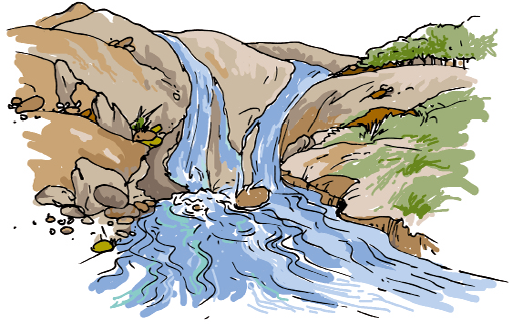
Fig. 14.8 Rainwater flows down in the form of streams and rivers
The rainwater also fills up the lakes and ponds. A part of the rainwater gets absorbed by the ground and seems to disappear in the soil. Some of this water is brought back to the air by the process of evaporation and transpiration. The rest seeps into the ground. Most of this water becomes available to us as ground water. Open wells are fed by ground water. Ground water is the source for many lakes as well. It is also this ground water which is drawn by a handpump or a tubewell. The more handpumps or tubewells that are used in an area, the deeper we need to dig to find this ground water. The loss in the level of ground water due to over use, is worrisome.
Paheli wants to share a concern with you. In those areas where the land has little or no vegetation, the rainwater flows away quickly. Flowing rainwater also takes the top layer of the soil away with it. There are few areas where most of the land is covered with concrete. This reduces the seepage of rainwater into the ground which ultimately affects the availability of ground water.
We now know that water brought back to the surface of the earth by rain, hail or snow, goes back to oceans. Thus, water from the ocean and surface of the earth goes into air as vapour; returns as rain, hail or snow and finally goes back to the oceans. The circulation of water in this manner is known as the water cycle (Fig.14.9). This circulation of water between ocean and land is a continuous process. This maintains the supply of water on land.
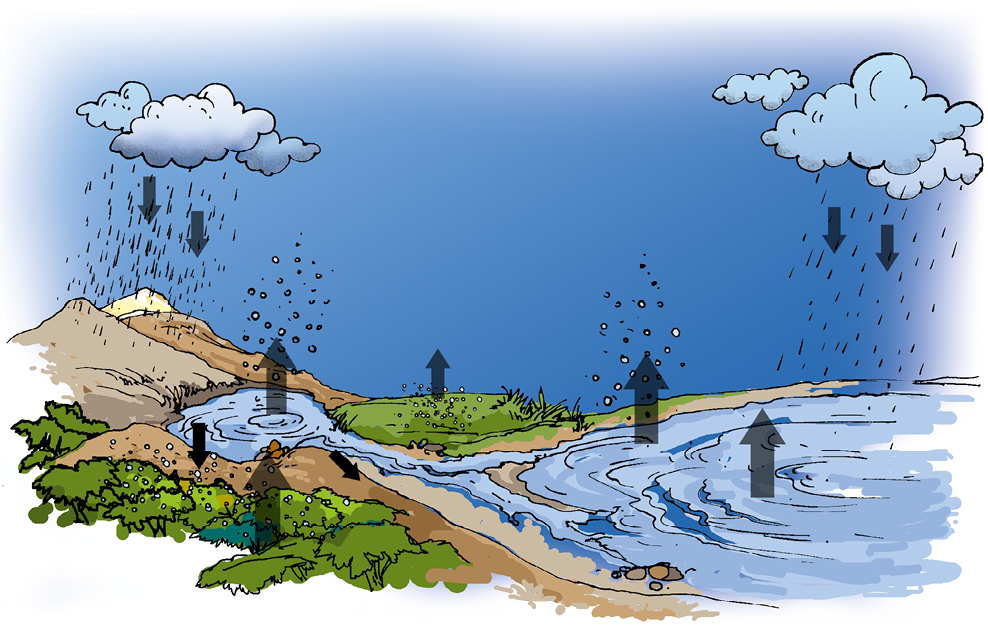
Fig. 14.9 Water cycle
14.5 What if it Rains Heavily?
The time, duration and the amount of rainfall varies from place to place. In some parts of the world it rains throughout the year while there are places where it rains only for a few days. In our country, most of the rainfall occurs during the monsoon season. Rains bring relief especially after hot summer days. The sowing of many crops depends on the arrival of monsoon.
However, excess of rainfall may lead to many problems (Fig. 14.10). Heavy rains may lead to rise in the level of water in rivers, lakes and ponds. The water may then spread over large areas causing floods. The crop fields, forests, villages, and cities may get submerged by water (Fig. 14.11). In our country, floods cause extensive damage to crops, domestic animals, property and human life.

Fig. 14.10 A scene after heavy rains
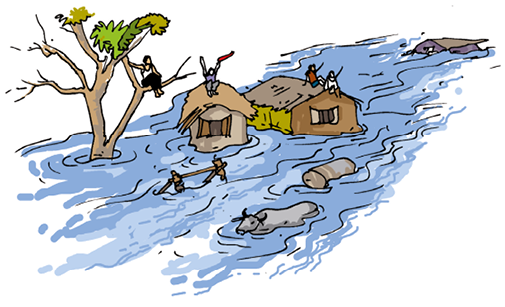
Fig. 14.11 A scene of a flooded area
During floods, the animals living in the water also get carried away with the waters. They often get trapped on land areas and die when floodwater recedes. Rains also affect the animals living in the soil.
14.6 What Happens if it does not Rain for a Long Period?
Can you imagine what would happen if it does not rain in a region for a year or more? The soil continues to lose water by evaporation and transpiration. Since it is not being brought back by rain, the soil becomes dry. The level of water in ponds and wells of the region goes down and some of them may even dry up. The ground water may also become scarce. This may lead to drought.
In drought conditions, it is difficult to get food and fodder. You might have heard about droughts occurring in some parts of our country or the world. Are you aware of the difficulties faced by the people living in these areas? What happens to the animals and the vegetation in these conditions? Try and find out about this by talking to your parents and neighbours and by reading about it from newspapers and magazines.
14.7 How Can We Conserve Water?
Only a small fraction of water available on the Earth is fit for use of plants, animals and humans. Most of the water is in the oceans and it cannot be used directly. When the level of the ground water decreases drastically, this can not be used any more. The total amount of water on Earth remains the same, but, the water available for use is very limited and is decreasing with over usage.
The demand for water is increasing day-by-day. The number of people using water is increasing with rising population. In many cities, long queues for collection of water are a common site (Fig. 14.12). Also, more and more water is being used for producing food and by the industries. These factors are leading to shortage of water in many parts of the world. Hence, it is very important that water is used carefully. We should take care not to waste water.
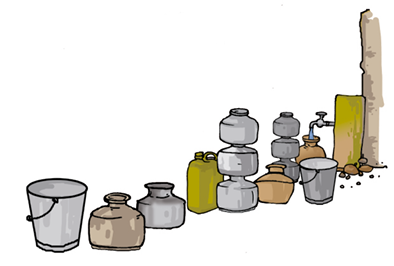
Fig. 14.12 A queue for collecting water
14.8 Rainwater Harvesting
One way of increasing the availability of water is to collect rainwater and store it for later use. Collecting rainwater in this way is called rainwater harvesting. The basic idea behind rainwater harvesting is “Catch water where it falls”.
What happens to the rainwater that falls in places that are mostly covered with concrete roads and buildings? It flows into the drains, isn’t it? From there water goes to rivers or lakes, which could be far away. A lot of effort will then be required to get this water back into our homes as the water did not seep into the ground.
Here two techniques of rainwater harvesting are discussed
1. Rooftop rainwater harvesting: In this system the rainwater is collected from the rooftop to a storage tank, through pipes. This water may contain soil from the roof and need filtering before it is used. Instead of collecting rainwater in the tank, the pipes can go directly into a pit in the ground. This then seeps into the soil to recharge or refill the ground water (Fig. 14.13).
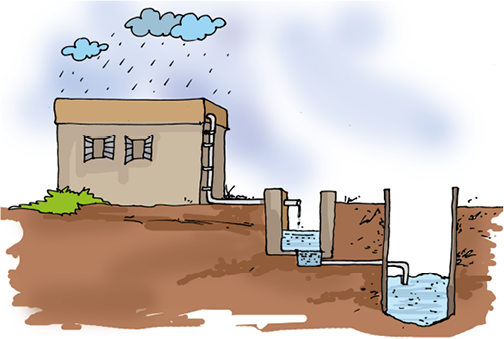
Fig. 14.13 Rooftop rainwater harvesting
2. Another option is to allow water to go into the ground directly from the roadside drains that collect rainwater.
KeyWords
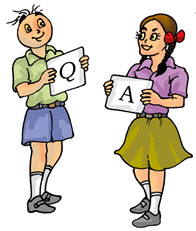
Summary
- Water is essential for life.
- Water vapour gets added to air by evaporation and transpiration.
- The water vapour in the air condenses to form tiny droplets of water, which appear as clouds. Many tiny water droplets come together and fall down as rain, snow or hail.
- Rain, hail and snow replenish water in rivers, lakes, ponds, wells and soil.
- The circulation of water between ocean and land is known as the water cycle.
- Excessive rains may cause floods while lack of it for long periods may cause droughts.
- The amount of usable water on earth is limited so it needs to be used carefully.
Exercises
1. Fill up the blanks in the following:
(a) The process of changing of water into its vapour is called _________________.
(b) The process of changing water vapour into water is called _________________.
(c) No rainfall for a year or more may lead to _________________ in that region.
(d) Excessive rains may cause _________________.
2. State for each of the following whether it is due to evaporation or condensation:
(a) Water drops appear on the outer surface of a glass containing cold water.
(b) Steam rising from wet clothes while they are ironed.
(c) Fog appearing on a cold winter morning.
(d) Blackboard dries up after wiping it.
(e) Steam rising from a hot girdle when water is sprinkled on it.
3. Which of the following statements are “true” ?
(a) Water vapour is present in air only during the monsoon. ( )
(b) Water evaporates into air from oceans, rivers and lakes but not from the soil.( )
(c) The process of water changing into its vapour, is called evaporation.( )
(d) The evaporation of water takes place only in sunlight.( )
(e) Water vapour condenses to form tiny droplets of water in the upper layers of air where it is cooler.( )
4. Suppose you want to dry your school uniform quickly. Would spreading it near an anghiti or heater help? If yes, how?
5. Take out a cooled bottle of water from refrigerator and keep it on a table. After some time you notice a droplets of water around it. Why?
6. To clean their spectacles, people often breathe out on glasses to make them wet. Explain why the glasses become wet.
7. How are clouds formed?
8. When does a drought occur?
suggested Projects and Activities
1. List three activities in which you can save water. For each activity describe how you would do it.
2. Collect pictures relating to floods or droughts from old magazines or newspapers. Paste them in your notebook and write about the problems that people would have faced.
3. Prepare a poster on ways of saving water and display it on your school notice board.
4. Write a few slogans of your own on the topic ‘Save Water’.
5. Can the interlinking of rivers be a solution for mitigation of flood? Discuss.
